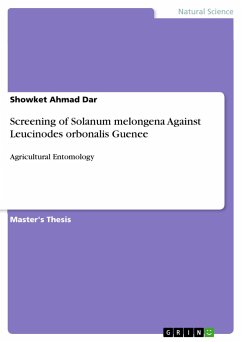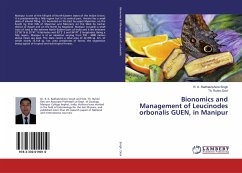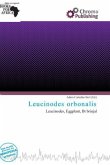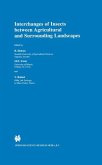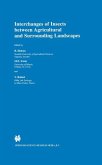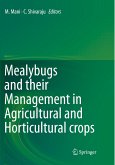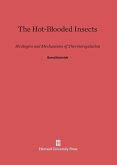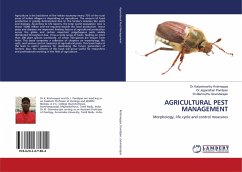Master's Thesis from the year 2012 in the subject Biology - Zoology, grade: A, Sher-e-Kashmir University of Agricultural Sciences and Technology of Jammu (SKUAST-K, srinager), course: Agriculture, language: English, abstract: The present investigations were carried out to screen some important varieties/genotypes of brinjal against Leucinodes orbonalis under field conditions and also to determine morphological, biochemical characteristics of brinjal showing some degree of tolerance against this pest. All 12 varieties/genotypes as treatment were raised in Randomized Block Design with 3 replications. The relative susceptibility of the various brinjal genotypes to Leucinodes orbonalis infestation was ascertained by recording number, weight of infested and uninfested fruits. Relative susceptibility of shoots was done by recording number of damaged/undamaged shoots from each entry up to harvest time and percentage calculated. Observations in respect of several morphological charactersincluding fruit length, fruit diameter, shape and volume index, length of peripheral seed ring, ratio of length of peripheral seed ring, length of seed less area, ratio of length of seed less area, pericarp thickness, shoot/leaf hairs, yield per plant, number of fruits per plant, plant height, number of branches per plant, roughness/smoothness of calyx, flower and fruit colour and biochemical characters including total phenols, total sugars, moisture and ash were assayed. Correlation between borer infestation with morphological and biochemical characters was also determined. All genotypes screened revealed that none of them were immune to the infestation of L.orbonalis. On the basis of level of infestation on number basis genotypes were grouped as: 2 resistant genotypes (Brinjal-85 and Local long); 2 fairly resistant (Shalimar Brinjal purple Round-8 and Shalimar Brinjal purple Round-1); 5 tolerant (Shalimar Brinjal purple Long-42, Shalimar Brinjal purple Long-208, Shalimar Brinjal Long-217, Dilruba-2 and Brinjal purple Long); 2 susceptible (Brinjal oblong, Shalimar Brinjal Hybrid-2) and one highly susceptible (Shalimar Brinjal Hybrid-1) while as, on weight basis one resistant, 2 fairly resistant, 4 tolerant, 3 susceptible and 2 highly susceptible. Five genotypes were recorded resistant and 7 as fairly resistant on the basis of mean percent shoot infestation. Shalimar Brinjal Hybrid-1(highly susceptible) and Shalimar Brinjal Hybrid-2 (susceptible) recorded the maximum fruit infestation of 23.07, 20.00 and 22.50, 21.75 per cent on number and weight basis, respectively. While as, Brinjal-85 and Local Long (resistant) genotypes suffered minimum fruit damage
Hinweis: Dieser Artikel kann nur an eine deutsche Lieferadresse ausgeliefert werden.
Hinweis: Dieser Artikel kann nur an eine deutsche Lieferadresse ausgeliefert werden.

